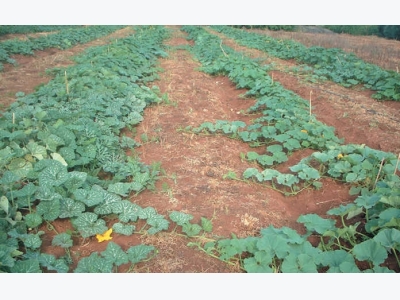Spacing, competition & yield

We sometimes tend to make assumptions about how a crop will react without considering the survival mechanisms inherited from its wild ancestors.
The runners of pumpkins must grow into open ground for the vegetable to mature properly. Photo: Bill Kerr
A good example is the way in which pumpkins react to spacing. Some years ago, the only pumpkins commercially grown in this country were open-pollinated varieties, mainly Flat White Boer.
Seed was cheap; the company I worked for sold 20t a year. It was only one of three large seed companies selling this variety. Because seed was cheap, the practice was to plant more than required for a full stand. At one time, government even recommended planting seed at up to 12kg/ha.
Most seed companies, however, suggested 2kg/ha to 3kg/ ha. At about 4 000 seeds/ kg, this was 48 000 seeds/ha.
When I grew this crop, I started doing some calculations. A good yield for the variety was 25t/ ha. At a weight of 5kg to 6kg per pumpkin, this gave 5 000 or fewer pumpkins per hectare. Simply put, one pumpkin was produced for every two seeds planted.
But as a seed company employee, I would not have been very popular for suggesting that farmers plant fewer seeds than were recommended!
Fewer seeds, yet higher yield!
We then introduced the first hybrid pumpkin, but the ‘standard’ spacing and seeding rate made the seed too expensive for most farmers. So we recommended planting seed at a rate of 500g/ ha, making the seed far more affordable.
At the same time – and this was the real discovery – we managed to produce a higher yield. My trials showed that when the runners from a row reached the stage where they started to join up, the plants began aborting fruit.
This stage was reached at different times for different growing conditions and seasons, making it impossible to come up with a standard row spacing. However, it turned out that the plants would start aborting fruit when the open ground was ‘covered’.
The plants were, in effect, fighting for survival. The first fruit formed would often be rather immature, but the plant reacted to competition by nourishing this fruit to seed maturity, thus ensuring seed for the next generation, rather than bearing too many fruits and not bringing any to maturity.
One of my clients planted a land to gem squash (the compact growing variety) at a rate of one row per bed, with the beds spaced 1,8m apart. Seeking to increase his yield, he planted two rows per bed on the adjoining land. To his surprise, the gems planted at one row per bed produced double the yield.
Use this to your advantage
Examine your crops carefully to understand how they react to different conditions. Remember that they originated in the wild and retain many survival characteristics that you can use to your advantage.
Bill Kerr is a vegetable specialist and a breeder of a range of vegetables.
Có thể bạn quan tâm
 Three Sisters Garden — How to Plant Corn, Squash & Beans Together
Three Sisters Garden — How to Plant Corn, Squash & Beans Together Most folks plant different vegetables in different rows of the garden. Perhaps this tendency is a product of our society’s need for order and control
 Over-stimulating vegetative growth
Over-stimulating vegetative growth The survival mechanisms that enabled the ancestors of modern crops to survive in the wild will influence the efficacy of the fertiliser we apply to these crops
 Urban Gardening 101: How to Deal with Contaminated Soil
Urban Gardening 101: How to Deal with Contaminated Soil A common motivation for growing food at home is the sense that it is safer to eat than store-bought food. When you grow it yourself